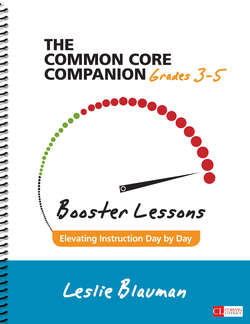Читать книгу The Common Core Companion: Booster Lessons, Grades 3-5 - Leslie Blauman - Страница 39
На сайте Литреса книга снята с продажи.
Core Connections
ОглавлениеGrade 4
Speaking and Listening Standard 1 (b, c, and d)
Students engage in a range of collaborative discussions with diverse partners on grade 4 topics and texts, building on others’ ideas and expressing their own clearly. They follow agreed-upon rules for discussion, pose and respond to specific questions to clarify or follow up on information, make comments that contribute to the discussion and link to the remarks of others, and review the key ideas expressed and explain their own ideas and understanding in light of the discussion.
T: Now that we’ve finished The Wolf’s Story I’d like you to turn and talk with your partner about your answer to “Who is telling the story and what is their point of view?” Remember to also share the specifics from the text that support your answer and thinking. Also, remember to follow our agreed-upon norms for sharing thinking with a partner.
These norms are
One student shares her thinking and why
Partner rephrases what he heard and adds to it—either agreeing or disagreeing and why
First student can either expand on the thinking and explanation or ask the partner to share his thoughts
This pattern is repeated; however, students should continue to discuss a point if it leads to deeper understanding
As students discuss, the teacher eavesdrops, nudging students when necessary or asking if they’d like to share their thinking with the whole group after partner time is finished.
Jose: It’s pretty obvious that the Wolf is telling the story and he thinks it’s not his fault, right?
A productive, successful conversation. The boys are following the class expectation of restating what they’ve heard before continuing the conversation. Doing so prevents students from just throwing out lots of thoughts without analysis. This type of back and forth takes time and practice.
Carson: I agree—remember when the Wolf said, “Would I lie to you?” And that the old woman started it? He’s like totally trying to change the story and blame her.
Jose: Yeah. I like the part about toffee. I get that it’s a candy, but what is it?
Carson: I’ve never had it either, but it’s got to be sticky, right? Cuz it made Grandma’s teeth stick together and it was actually pretty important to the story. Remember at the end when the Wolf thought Red was going to put toffee in his mouth and he jumped out of bed and she thought he was going to eat her and that he’d eaten the Grandma? That really showed his point of view, that he didn’t do anything wrong, but she thought he did.
Jose: And she started screaming and the woodsman came in. Maybe we could ask Ms. B what toffee is?
Notice how Jose and Carson are really listening to each other. When they get to “toffee” they use context clues to get the gist. Both boys have the word written on one of their sticky notes. Readers need to pay attention to vocabulary—and words they don’t know. The boys wave me over (even though I’ve been listening) and ask what toffee is. I explain and ask them how that helps them understand the text better. They tell me and then I ask if they will share with the whole group how even though they not only deduced its meaning, but its importance to the plot.
Carson: This book was funny. It was like the Wolf talked like us—and like he talked right to us. He used “you” to talk to us and made it funny. Like the part where he was trying to help Grandma get her dress and she fell and knocked herself out and he said something like “Not everybody trusts a wolf and he thought they might blame him for doing something bad to Grandma and he said ME?” that was funny and showed that he thought he was innocent.
Now the boys have turned their attention to the language and style of the text. This book is written in an informal way with a lot of humor, which makes it a good text for teaching POV. Also notice how the boys are questioning the Wolf, but not the point of view. While the focus of this lesson was Reading Standard 6, the boys are working on numerous reading standards simultaneously!
Jose: Yeah, but was he? Or was he like making excuses and trying to persuade us that it’s not his fault?
Carson: Maybe. You could be right. Now I want to read the book again. But I still say his point of view was that it was not his fault and that he didn’t hurt anybody.
